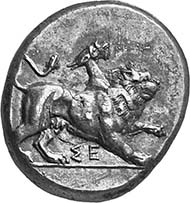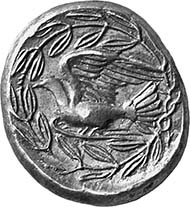by courtesy of Hans Voegtli / ACAMA
When Pausanias visited Sikyon in 160 AD he found it deserted. In 140 AD an earthquake had laid in ruins the formerly rich and magnificent city, so that the traveling author was only able to see the sad remnants.
How different Sikyon must have appeared in the middle of the fifth century BC when the first staters of the type Chimaira / Dove were invented. Then Sikyon was the wealthy capital of a fertile plain famous for its fruit and vegetables, its wines and olives. The whole area was named field of cucumbers (gr. Sikyonia) after the cucumbers that were growing there. In addition the city was famous for being a center of arts: Polykleitos, Kanachos and Lysippos were living and working in Sikyon to name just a few of the famous artists.
SIKYON. Stater, ca. 390 BC. Chimaira r. Rev. Dove flying l. in wreath of olive twigs. 12.10 g. SNG Lockett 2323.
No wonder that the staters of Sikyon belong to the most beautiful coins that have been engraved by Greek craftsmen. How realistic the legendary creature Chimaira is modeled! Clearly we see the three elements from which the beast was composed: The head and the body of the lion, the tail formed by the head and the body of a snake, and in the middle the head of the animal that gave its name to the whole of the creature: the goat, called in Greece Chimaira (= c?meira). This monster was considered to be the sister of the hell-hound Cerberus, of the polycephalous Hydra that was killed by Heracles and of the Sphinx from Thebes. Her breath was fire and that was the reason why ancient mythologists already connected her to the fire-spitting volcanoes. Sikyon was far away from any volcano. So why did the aristocrats of Sicyon choose this motif as symbol of their community? Why did they banish the dove that former had been their emblem to the reverse of their coins?
The dove was connected to one of the main deities of Sikyon, to Aphrodite. She owned a very important temple in Sikyon, where her statue of gold and ivory made by Kanachos was located. Kanachos was a famous artist who is known in the history of art for having created the statue of Apollo in Didyma. Pausanias saw the statue of Aphrodite and he gave a careful description: The goddess was sitting on a throne and she wore a polos on her head, in one hand she held a blossom of poppy, in the other hand an apple; this kind of presentation was not the common way of depicting Aphrodite. Her priestesses also had – for priestesses of Aphrodite – unusual rules to observe: The “carrier of the bath” had to be a virgin, her colleague had to live celibate. Only in a few other cities Aphrodite attached great importance to the modest manners of her servants. The Aphrodite of Sikyon seems to have integrated the characteristics of a native pre-greek goddess. So it can’t surprise that in the North of the Peloponnesos Demeter and Aphrodite share in part attributes and cultic names.
The most beautiful statue of Chimaira – the “Chimaira of Arezzo” – is found in the archaeological Museum of Florence. Photo: Lucarelli / Wikipedia.
But let’s return to the obverse, to Chimaira. There are two possible explanations for the choice of the Sikyonians: To begin with, the myth of Bellerophon was located near the city. Korinthos was thought to be the place where Bellerophon tamed the Pegasus to bring him into action against the Chimaira. For that reason several scholars think that there must have existed local myths placing the fight of Bellerophon against the Chimaira near Sikyon. The motif of Chimaira was chosen for the coinage to refer to the glorious past of the city. But since Homer Greece has accepted a divergent version: The Chimaira was thought to be a creature of Lycia, where numerous dynasts boasted to be descendants of Bellerophon. That was the reason why Léon Lacroix was looking for another connection of the Chimaira and Sikyon. He thinks that the Chimaira was refering to an old, to the original name of the city of Sikyon, Aigialeia. The radical of the name Aigialeia derives – according to Lacroix – from the Greek aix (= aix), another word for goat. The most important part of the Chimaira that gave the name to the monster was the head of the goat. The staters of Sikyon are perhaps comparable to the coinage of Aigai or of Aigeira showing a goat referring to the cities’ names.
During the Peloponnesian war the members of the Spartan League paid all their costs of war with the coins of Sikyon after Aegina had been lost to Athens. The Chimaira brought the city’s name to the whole of the Greek world, and doubtless the Sikyonians had a wonderful story how the legendary creature was connected to their city. But local tradition did not survive. Pausanias came nearly a generation too late to ask the natives about their myths. Therefore we never will really know why the Sikyonians have chosen Chimaira to represent their city on their coinage.
Bethe, s. v. Bellerophon, RE V (1897), 241-251.
C. M. Kraay, Archaic and Classical Greek Coins, London 1976.
L. Lacroix, Quelques aspects de la numismatique sicyonienne, RBN 110 (1964) 5-52.
Lippold, s. v. Sikyon, RE II/2 (1923), 2528-2549.








